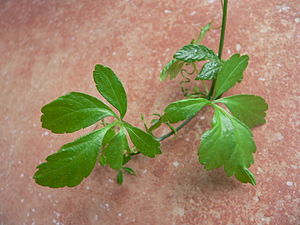Note: This is a project under development. The articles on this wiki are just being initiated and broadly incomplete. You can Help creating new pages.
Difference between revisions of "Gynostemma pentaphyllum - Jiaogulan"
(Created page with "thumb|right|''Jiaogulan'', ''Gynostemma pentaphyllum'' '''Jiaogulan''', also called '''Gynostemma pentaphyllum''', literally "stranded blue plant", is...") |
(No difference)
|
Revision as of 16:41, 5 January 2017
Jiaogulan, also called Gynostemma pentaphyllum, literally "stranded blue plant", is a dioecious, herbaceous climbing vine of the family Cucurbitaceae (cucumber or gourd family) indigenous to the southern reaches of China, northern Vietnam, southern Korea, and Japan. Jiaogulan is best known as an herbal medicine reputed to have powerful antioxidant and adaptogenic effects purported to increase longevity.[1]
Contents
Description
Jiaogulan belongs to the genus Gynostemma, in the family Cucurbitaceae, which includes cucumbers, gourds, and melons, although it lacks the characteristic fruit. It is a climbing vine, attaching itself to supports using tendrils. The serrated leaflets commonly grow in groups of five (as in G. pentaphyllum) although some species can have groups of three or seven leaflets. The plant is dioecious, meaning each plant exists either as male or female. Therefore, if seeds are desired, both a male and female plant must be grown.
Uses
- The plant is best known for its use as a herbal medicine. Jiaogulan is most often consumed as an herbal tea, and is also available as an alcohol extract and in capsule or pill form.
- Jiaogulan is known as an adaptogen, which is an herb reputed to help the body to maintain optimal homeostasis.
- The adaptogenic nature of gypenosides have been found to keep blood pressure in a normal range. In vitro studies indicate that jiaogulan stimulates the release of nitric oxide in isolated heart cells; this is one proposed mechanism by which jiaogulan reduces high blood pressure.
- Gynostemma pentaphyllum tea has been studied in a randomized controlled trial in type 2 diabetic patients.[2] It may have potential as a hypoglycemic treatment to reduce blood glucose.[3]
References
- ↑ Blumert, Michael; Jialiu Liu (2003). Jiaogulan: China's "Immortality" Herb. Badger, CA: Torchlight Publishing. p. 12.
- ↑ Huyen VT, Phan DV, Thang P, Hoa NK, Ostenson CG (May 2010). "Antidiabetic effect of Gynostemma pentaphyllum tea in randomly assigned type 2 diabetic patients". Hormone & Metabolic Research.
- ↑ Hoa NK, Phan DV, Thuan ND, Ostenson CG (April 2009). "Screening of the hypoglycemic effect of eight Vietnamese herbal drugs". Methods & Findings in Experimental & Clinical Pharmacology. 31 (3): 165–9.
